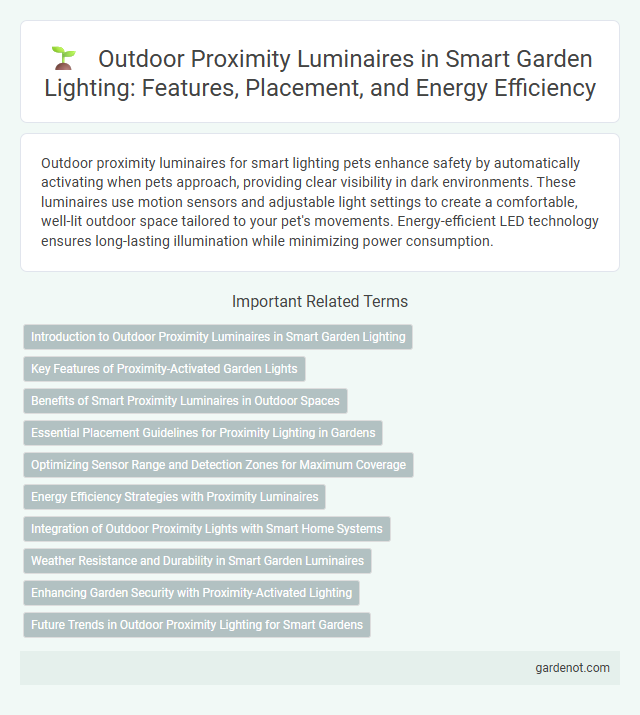Outdoor proximity luminaires for smart lighting pets enhance safety by automatically activating when pets approach, providing clear visibility in dark environments. These luminaires use motion sensors and adjustable light settings to create a comfortable, well-lit outdoor space tailored to your pet's movements. Energy-efficient LED technology ensures long-lasting illumination while minimizing power consumption.
Introduction to Outdoor Proximity Luminaires in Smart Garden Lighting
Outdoor proximity luminaires in smart garden lighting enhance safety and energy efficiency by automatically adjusting illumination based on motion detection and ambient light levels. These smart fixtures use sensors to activate lighting only when movement or presence is detected within a designated range, minimizing energy waste. Integration with smart home systems enables remote control and customization of lighting patterns, optimizing garden ambiance and security.
Key Features of Proximity-Activated Garden Lights
Proximity-activated garden lights use motion sensors to detect nearby movement, ensuring energy efficiency by illuminating only when presence is detected. These outdoor luminaires often feature adjustable sensitivity and timer settings, allowing customization for varied garden sizes and activity levels. Weather-resistant materials and solar power integration enhance durability and sustainability for prolonged outdoor use.
Benefits of Smart Proximity Luminaires in Outdoor Spaces
Smart proximity luminaires in outdoor spaces enhance energy efficiency by dynamically adjusting light levels based on nearby movement detection, reducing unnecessary power consumption. These advanced lighting systems improve safety and security by providing immediate illumination in response to pedestrian or vehicle presence, deterring potential hazards and criminal activity. Integration with IoT technology allows real-time monitoring and remote control, optimizing maintenance and operational costs for urban and residential environments.
Essential Placement Guidelines for Proximity Lighting in Gardens
Outdoor proximity luminaires should be installed at heights between 1 to 1.5 meters to ensure optimal illumination of pathways and garden features while minimizing glare. Position lights near walkways, plant beds, and seating areas to enhance safety and highlight landscape textures without overwhelming the natural ambiance. Use fixtures with adjustable angles and warm color temperatures (2700K-3000K) to create functional yet inviting outdoor spaces that support navigation and aesthetic appeal.
Optimizing Sensor Range and Detection Zones for Maximum Coverage
Optimizing sensor range and detection zones in outdoor proximity luminaires enhances energy efficiency and security by ensuring precise activation within targeted areas. Advanced motion detection technology allows for customizable coverage patterns, reducing false triggers while maximizing illumination where needed. Proper calibration of sensor sensitivity and range aligns lighting response with environmental factors, ensuring reliable operation in diverse outdoor settings.
Energy Efficiency Strategies with Proximity Luminaires
Outdoor proximity luminaires enhance energy efficiency by activating lighting only when motion or presence is detected within a designated area, significantly reducing unnecessary power consumption. These smart lighting systems utilize sensors and adaptive controls to adjust brightness levels based on ambient light conditions and occupancy patterns. Integrating wireless connectivity allows for real-time monitoring and optimization, leading to sustainable energy management in urban and residential outdoor environments.
Integration of Outdoor Proximity Lights with Smart Home Systems
Outdoor proximity luminaires seamlessly integrate with smart home systems through advanced IoT connectivity, enabling remote control and automation via mobile apps or voice assistants. These lights use motion sensors and ambient light detection to optimize energy efficiency while enhancing security around properties. Integration with platforms like Google Home, Amazon Alexa, and Apple HomeKit ensures synchronized lighting scenarios based on proximity and user preferences.
Weather Resistance and Durability in Smart Garden Luminaires
Outdoor proximity luminaires for smart gardens are engineered with high-grade weather-resistant materials such as anodized aluminum and IP65-rated seals to withstand rain, snow, and UV exposure. Advanced coatings protect against corrosion and fading, ensuring long-term durability in diverse climates. These robust luminaires maintain optimal performance and energy efficiency, enhancing garden security and ambiance year-round.
Enhancing Garden Security with Proximity-Activated Lighting
Outdoor proximity luminaires enhance garden security by automatically illuminating when motion is detected within a specified range, deterring potential intruders. These smart lighting solutions use infrared or ultrasonic sensors to activate bright, energy-efficient LEDs only when needed, reducing energy consumption and light pollution. Integrated with home automation systems, proximity-activated lighting provides real-time alerts and customizable settings for optimized outdoor safety.
Future Trends in Outdoor Proximity Lighting for Smart Gardens
Future trends in outdoor proximity luminaires for smart gardens emphasize energy-efficient LED technology combined with advanced motion sensors to optimize light activation based on real-time user presence. Integration with IoT platforms enables adaptive lighting schedules and remote control, enhancing security and ambiance while reducing energy consumption. Emerging innovations focus on solar-powered units with AI-driven analytics for predictive maintenance and personalized lighting experiences.
Outdoor proximity luminaire Infographic

 gardenot.com
gardenot.com